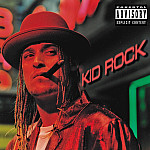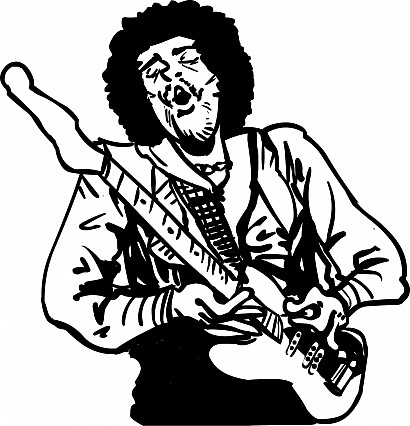18 AUGUST
Featured Events
 1998 After getting dropped by Jive and releasing two independent albums, Kid Rock issues Devil Without A Cause, his first album with Lava Records. It sells 11 million copies, making the rumpled rap-rocker a huge star.More
1998 After getting dropped by Jive and releasing two independent albums, Kid Rock issues Devil Without A Cause, his first album with Lava Records. It sells 11 million copies, making the rumpled rap-rocker a huge star.More
1992 Frances Bean Cobain is born to Courtney Love and Nirvana's Kurt Cobain.
1984 After years toiling in clubs, Red Hot Chili Peppers release their self-titled debut album.
1979 Chic's "Good Times" hits #1 in America as disco still has some dance. It holds the top spot for one week.
1979 Nick Lowe marries Johnny Cash's stepdaughter, country singer Carlene Carter, in Los Angeles. The wedding is reenacted in Lowe's video for "Cruel To Be Kind." The pair get divorced in 1990.
1955 Pete Seeger testifies before the House Un-American Activities Committee, where he is asked if he has performed for communists. Seger replies: "I have sung for Americans of every political persuasion, and I am proud that I never refuse to sing to an audience, no matter what religion or color of their skin, or situation in life. I have sung in hobo jungles, and I have sung for the Rockefellers, and I am proud that I have never refused to sing for anybody."
18 AUGUST
In Music History
2017 Taylor Swift wipes clean her social media accounts (Facebook, Twitter, Instagram, personal YouTube). Three days later, she begins posting video of a snake to tease her scathing song "Look What You Made Me Do," which is released on August 25.
2012 Pop singer-songwriter Scott McKenzie dies at age 73 in Los Angeles, California, after a two-year struggle with Guillain-Barre syndrome.
2011 During a severe storm, high wind and heavy rain cause a stage to collapse while Chicago band Smith Westerns are performing. Four are killed and over 70 injured. Organizers decide to cancel the festival, where Eminem, Face to Face and Foo Fighters were scheduled to perform.
2004 Film score composer/conductor Elmer Bernstein dies of cancer in Ojai, California, at age 82.
2003 Singer/bass player Tony Jackson (of The Searchers) dies from a combination of health issues - including diabetes, heart disease and cirrhosis of the liver - in Nottingham, England, at age 65.
1999 Alanis Morissette and Tori Amos launch their 5 1/2 Weeks Tour in Ft. Lauderdale, Florida. It's sponsored by MP3.com, a hot tech company that lets users download songs for free. Morissette gets stock in the company as part of the deal.
1991 Billy Preston is arrested on charges of battery after allegedly attacking a 16-year-old prostitute once Preston discovered he was a transvestite. The keyboardist and singer is eventually given five years probation.
1986 Bon Jovi release their third album, Slippery When Wet, which catapults them to the top with the hits "You Give Love A Bad Name" and "Livin' On A Prayer." Seasoned from years of touring, the group is ready for the big crowds and quickly become a top live draw.
1982 The Beatles' hometown of Liverpool, England, renames some streets in honor of the band members. There is John Lennon Drive, Paul McCartney Way, George Harrison Close, Ringo Starr Drive, and even Sutcliffe Street (in honor of original bass player Stu Sutcliffe).
1978 The Temptations' Melvin "Blue" Franklin is shot four times in the hand and leg during an attempted carjacking in Los Angeles, but survives.
1977 Elvis Presley's funeral is held at Graceland, where 150 guests are invited inside and about 75,000 fans pay their respects outside.
1973 Jazz drumming legend Gene Krupa plays what is to be his last live show, a gig with the Benny Goodman Quartet in New York City.
1973 Conway Twitty and Loretta Lynn's "Louisiana Woman, Mississippi Man" hits #1 on the country chart.
1973 Diana Ross' "Touch Me In The Morning" hits #1, where it stays for one week.
1973 Jethro Tull's album A Passion Play hits #1 in America.
Hendrix Wakes Up Woodstock With "Star-Spangled Banner"
 1969
1969Jimi Hendrix closes out Woodstock with an early morning performance of "Hey Joe." The festival headliner, he was supposed to play the previous night, but when it ran long, he ended up taking the stage on a Monday morning. His set includes a scorching rendition of "The Star Spangled Banner."
While shutting down Woodstock, Hendrix becomes a human tuning fork for the '60s zeitgeist, dousing the US national anthem in tie-dyed mix of rage and exuberance. Some say the guitarist is possessed by the spirit of God as he plays. Others say it's the Devil. Nobody questions that he's possessed by something. On the fourth and last day of Woodstock, the festival grounds look more like a refugee camp than a musical festival. Considering the revolutionary stance held by most on the scene, "refugee camp" is probably an apt comparison that the participants themselves would embrace. The festival's peak attendance of around 400,000 has dwindled to less than 200,000. Those who remain are exhausted and filthy. Hendrix takes the stage wearing a white, fringed coat reminiscent of Native American garb, coupled with blue jeans. He is calling his backing band Gypsy Sun & Rainbows, rather than the formerly held Jimi Hendrix Experience. In this new lineup, Billy Cox replaces Noel Redding on bass and Larry Lee is added as a second guitarist. The group has only had time to do two rehearsals. None of that seems to matter, however, as Hendrix teases a few notes from "Voodoo Child (Slight Return)" before ripping into a furious, psychedelic interpretation of "The Star Spangled Banner." Hendrix is like a fire lizard, many times seeming on the verge of spinning out of control into madness or ecstasy before masterfully grabbing hold and bringing it back under wraps. The performance acts as a Rorschach text for all who see it. Many, such as Heart's Ann Wilson, hear explosions and gunshots in the song and view it as a statement against the Vietnam War. Others hear a threat to all that traditional America holds dear. As for the artist himself, he tells Dick Cavett that the performance wasn't blasphemous or combative. To him, it was simply "beautiful." Hendrix's "Star Spangled Banner" sears itself into the psyche of the '60s generation. Somehow, in its distorted way, the performance gives sound to all the semi-rational hopes and fears of the era. For many, it is the defining moment of a defining cultural event.
Categories
©2024 Songfacts®, LLC

Comments: 1
send your comment